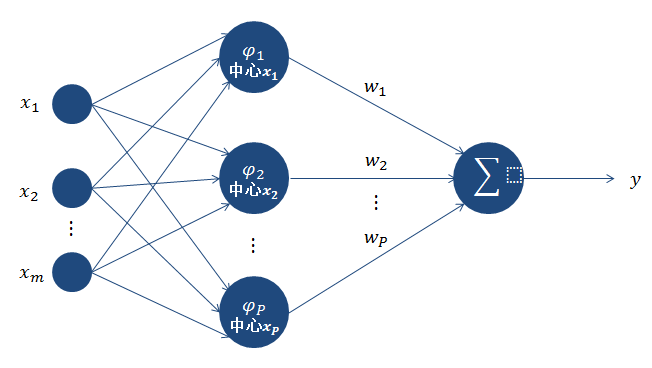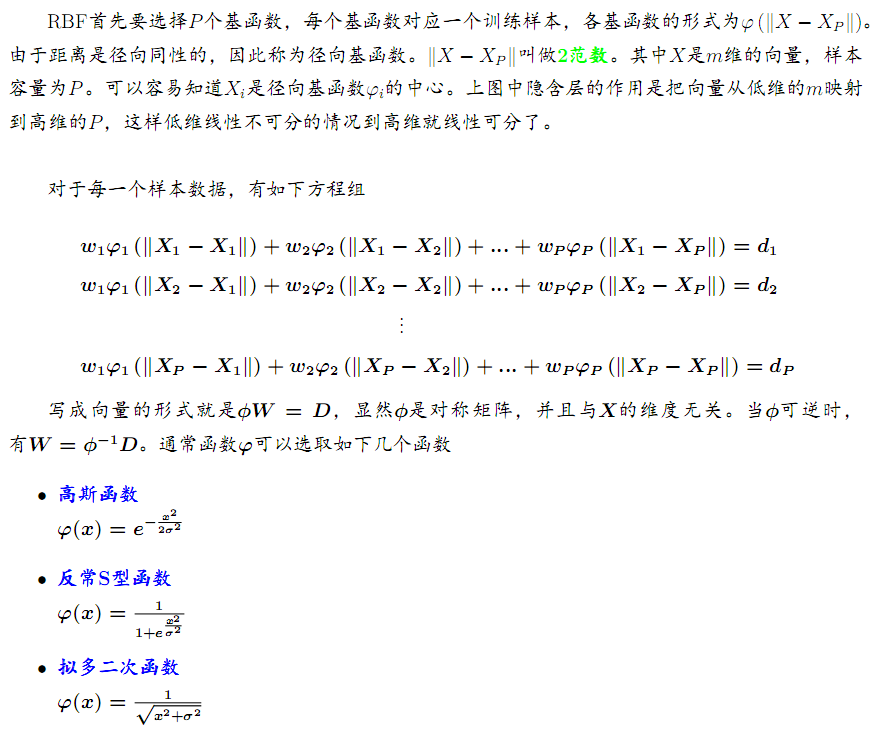徑向基(RBF)神經網路
阿新 • • 發佈:2019-02-13
RBF網路能夠逼近任意非線性的函式。可以處理系統內難以解析的規律性,具有很好的泛化能力,並且具有較快的學
習速度。當網路的一個或多個可調引數(權值或閾值)對任何一個輸出都有影響時,這樣的網路稱為全域性逼近網路。
由於對於每次輸入,網路上的每一個權值都要調整,從而導致全域性逼近網路的學習速度很慢,比如BP網路。如果對於
輸入空間的某個區域性區域只有少數幾個連線權值影響輸出,則該網路稱為區域性逼近網路,比如RBF網路。接下來重點
先介紹RBF網路的原理,然後給出其實現。先看如下圖
正則化的RBF網路參考這裡。下面是網上找的一個比較好的Python的RBF網路實現。
程式碼:
from scipy import * from scipy.linalg import norm, pinv from matplotlib import pyplot as plt class RBF: def __init__(self, indim, numCenters, outdim): self.indim = indim self.outdim = outdim self.numCenters = numCenters self.centers = [random.uniform(-1, 1, indim) for i in xrange(numCenters)] self.beta = 8 self.W = random.random((self.numCenters, self.outdim)) def _basisfunc(self, c, d): assert len(d) == self.indim return exp(-self.beta * norm(c-d)**2) def _calcAct(self, X): # calculate activations of RBFs G = zeros((X.shape[0], self.numCenters), float) for ci, c in enumerate(self.centers): for xi, x in enumerate(X): G[xi,ci] = self._basisfunc(c, x) return G def train(self, X, Y): """ X: matrix of dimensions n x indim y: column vector of dimension n x 1 """ # choose random center vectors from training set rnd_idx = random.permutation(X.shape[0])[:self.numCenters] self.centers = [X[i,:] for i in rnd_idx] print "center", self.centers # calculate activations of RBFs G = self._calcAct(X) print G # calculate output weights (pseudoinverse) self.W = dot(pinv(G), Y) def test(self, X): """ X: matrix of dimensions n x indim """ G = self._calcAct(X) Y = dot(G, self.W) return Y if __name__ == '__main__': n = 100 x = mgrid[-1:1:complex(0,n)].reshape(n, 1) # set y and add random noise y = sin(3*(x+0.5)**3 - 1) # y += random.normal(0, 0.1, y.shape) # rbf regression rbf = RBF(1, 10, 1) rbf.train(x, y) z = rbf.test(x) # plot original data plt.figure(figsize=(12, 8)) plt.plot(x, y, 'k-') # plot learned model plt.plot(x, z, 'r-', linewidth=2) # plot rbfs plt.plot(rbf.centers, zeros(rbf.numCenters), 'gs') for c in rbf.centers: # RF prediction lines cx = arange(c-0.7, c+0.7, 0.01) cy = [rbf._basisfunc(array([cx_]), array([c])) for cx_ in cx] plt.plot(cx, cy, '-', color='gray', linewidth=0.2) plt.xlim(-1.2, 1.2) plt.show()
最後提供Github上的一個,供日後參考。



